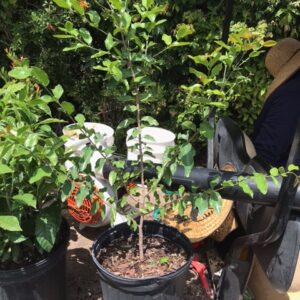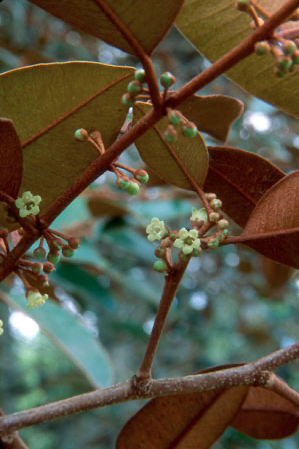General Landscape Uses: Accent or specimen tree.
Ecological Restoration Notes: Originally described as a distinct species, plants in Florida are native to freshwater swamps and wet hammocks, while plants of Cuba and elsewhere are found in a wider variety of habitats including mesic uplands. Anecdotally, there was an insufficient local supply to meet the demand in Florida in the early 1900s, and large numbers of royal palms were imported from Cuba. Widely cultivated for decades, these palms are now naturalized in forest ecosystems nearly throughout southern Florida and spreading north. Because of their size and weight, the fronds can be quite destructive when they fall, breaking branches and crushing small trees.
Description: Medium to large tree
Dimensions: Typically 30-50 feet; to 99 feet in South Florida; much taller than broad.
Growth Rate: Moderate to fast.
Range: Peninsular Florida, the West Indies, Mexico, and Central America; widely cultivated and naturalized outside of its natural range. In Florida, native from southern Miami-Dade County to southern Collier County, especially in and around the Fakahatchee Strand. Originally described from plants growing along the banks of the St. John’s River near Lake George, but never reported again from that area.
Habitats: Swamps and wet hammocks.
Soils: Moist to seasonally wet, moderately well-drained to well-drained sandy, limestone, or organic soils, with humusy top layer.
Nutritional Requirements: Moderate; can grow in nutrient poor soils, but needs some organic content to thrive.
Salt Water Tolerance: Low; does not tolerate flooding by salt or brackish water.
Salt Wind Tolerance: Moderate; grows near salt water, but does not tolerate direct and constant salt wind exposure.
Drought Tolerance: Moderate to low; requires moist to wet soils, but tolerant of short periods of drought once established.
Light Requirements: Full sun.
Flower Color: Pinkish to white.
Flower Characteristics: Inconspicuous.
Flowering Season: All year; peak in spring.
Fruit: Berry.
Wildlife and Ecology: Provides significant food and moderate amounts of cover for wildlife. Flowers attract bees, birds, and other insects. Fruit attracts larger fruit-eating birds. The crown supports a wide variety of wildlife, including tree frogs, snakes, and many species of birds. Dead trunks provide nesting cavities for Red-bellied woodpeckers and Pileated woodpeckers.
Horticultural Notes: Easily grown from seed.
Comments: Synonyms: Roystonea elata.










Christopher Martinez –
Delivery was fast and installation looks great! Staff are polite and professional. Thank you Smarty Plants!